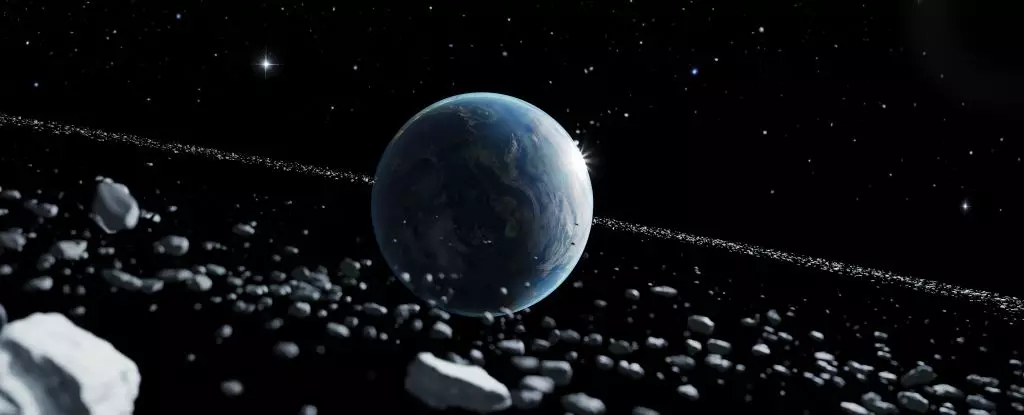In a time long before the present, Earth may have had its own magnificent planetary ring, akin to those of Saturn and Jupiter. Though this celestial feature likely existed for only a brief cosmic moment—tens of millions of years—it leaves us with intriguing geological insights. Research led by planetary scientist Andy Tomkins at Monash University in Australia proposes that this ring, if it existed during the Ordovician period nearly 466 million years ago, could explain a distinctive geological phenomenon known as the Ordovician impact spike. Tomkins and his team embarked on a mission to unravel this enigma, suggesting that debris from a disintegrated asteroid in orbit around Earth may account for an observed surge in meteorite impacts during that time.
Tomkins expressed a sense of wonder about what Earth might have looked like with a celestial ring overhead, noting that such a sight would have dramatically altered the visual appearance of our planet. This exploration is not just an engaging intellectual exercise; it also plays a significant role in how we understand Earth’s evolutionary history and its geological narrative.
The Ordovician period marks an era characterized by a sudden increase in meteorite impacts, lasting approximately 40 million years. This spike in activity is intimately connected to an array of craters that were formed in close spatial and temporal proximity. Tomkins’s team meticulously analyzed 21 impact craters, determining they fall within a mere 30 degrees of the equator. This points to a fascinating phenomenon: the clustering of impacts in a specific region, almost signaling a delivery of meteorite material from a narrow orbital band, reminiscent of a ring for the Earth.
Notably, the examination of sedimentary rock layers from this epoch reveals significant traces of meteorite debris, corroborating the hypothesis that Earth may have been bombarded by remnants of a celestial body. However, while the prevalence of meteorites dramatically escalated during this timeframe, their fall was geographically restricted, an anomaly that piques curiosity.
The Role of Tidal Forces and the Roche Limit
According to Tomkins and his colleagues, a likely scenario involves a loosely bound asteroid straying close enough to Earth to be torn apart by tidal forces at a distance known as the Roche limit. This distance, about 15,800 kilometers (roughly 9,800 miles) above Earth, is crucial since it allows debris to settle into orbit around Earth before gradually falling down over time. This principle mirrors occurrences seen throughout the Solar System, evidenced by Saturn’s rings and incidents where celestial bodies have been dismantled by gravitational forces—particularly the well-documented case of comet Shoemaker-Levy 9 crashing into Jupiter.
This paradigm offers a plausible explanation for the interconnected phenomena—both the clustered craters and meteorite material found in geological layers—pointing to a singular disintegrated asteroid event. One cannot help but wonder how our planet might have been shaped by such chaotic yet fascinating intercelestial interactions.
Towards the conclusion of the Ordovician, approximately 445 million years ago, Earth was thrust into a significant ice age, one of the coldest periods of the last half-billion years. The potential presence of a ring around Earth during this time could have intensified climatic changes by casting shadows that affected local temperature variations. Although this proposition is still in its infancy—including speculation that requires rigorous scientific verification—it nonetheless offers a captivating avenue for further research.
Tomkins emphasized the need for comprehensive numerical modeling to simulate the disintegration of the asteroid, as well as the ring formation and potential climatic repercussions. Through this modeling, scientists could explore the ring’s structure and whether its shadow could have induced substantial climatic shifts.
Interestingly, the era of the Ordovician not only witnessed significant geological changes but also remarkable biological diversity, marked by the Great Ordovician Biodiversification Event. Rapid climate shifts during this epoch may have propelled evolutionary adaptations among organisms, potentially correlating with the impact spike driven by the hypothetical ring.
Additionally, Tomkins proposes an imaginative avenue of future exploration: the idea of utilizing similar cosmic interventions to terraform inhospitable planets such as Venus. Redirecting an asteroid to create a cooling ring could theoretically lead to considerable atmospheric changes, paving the way for habitable conditions. Although this concept remains squarely within the realm of speculation, it sparks the imagination regarding humanity’s role in altering celestial environments.
As we delve further into Earth’s geological past, the notion of its being encircled by a ring tantalizes the mind, urging us to deepen our understanding of planetary evolution and the dynamic processes that shape our world. While the probability of this celestial ring existing remains uncertain, the exploration into its potential implications opens wide doors for scientific inquiry that connects geology, climatology, and astrobiology in engaging ways.

